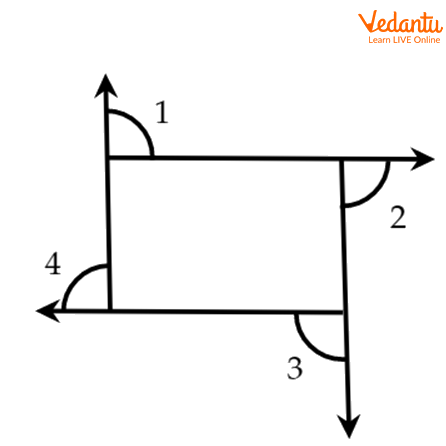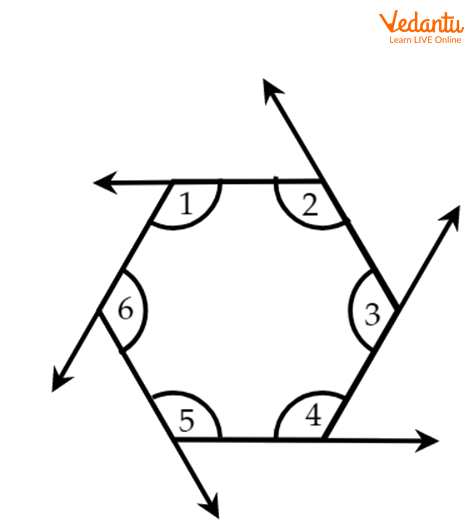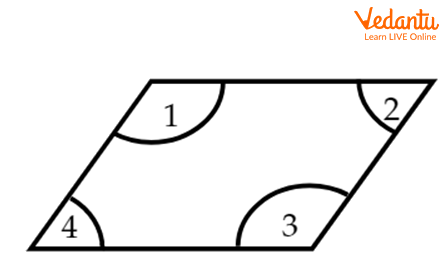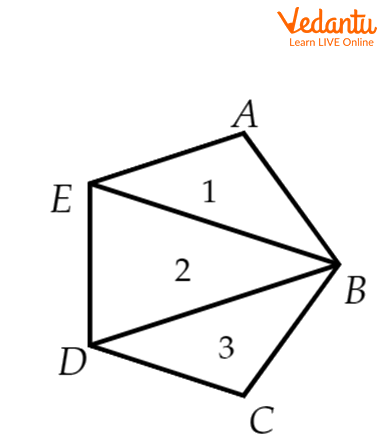




How to Find Exterior Angles of Any Polygon: Step-by-Step Guide
A polygon is a two-dimensional shape with a minimum of three sides. The sides may be four, five and so on. The polygon is divided into two parts: regular polygon and irregular polygon. The sum of measures of the exterior angles is the sum of all exterior angles formed in the polygon. In this article, we will learn about exterior angles and the sum of all exterior angles of a polygon.
Exterior Angle
When the side of a polygon is extended, the angle formed outside the figure is called the exterior angle. It is formed between the extended side and the adjacent side.

Four Exterior Angles of a Polygon
Properties of the Exterior Angles of a Polygon
The exterior angle has different properties. Let us consider a hexagon, which is a polygon. Following are the properties, which tell us about the exterior angles:
They are formed on the outside of the given figure.
The sum of the interior and exterior angles formed by the extended side and the adjacent side is always\[180^\circ \].
In the figure, angles 1, 2, 3, 4, 5 and 6 are the exterior angles.

Hexagon
The exterior angles of a regular polygon are always equal to each other.
Sum of Exterior Angles of a Polygon
As we have taken the hexagon here, we start from the first vertex and proceed in the clockwise direction. The bending happens at the different vertices 2, 3, 4, 5 and 6 and ends at vertex 1. In this way, we covered a full rotation and this complete angular rotation is \[360^\circ \]. Therefore, it concludes that the sum of exterior angles of a polygon is \[360^\circ \].

Exterior Angle
Proof of Sum of the Exterior Angles of the Polygon
Let us consider the polygon is a convex polygon with n number of sides and N is the sum of its exterior angles.
By the exterior angle theorem,
The sum of exterior angles is equivalent to the sum of interior angles and the sum of linear pairs.
\[\;{\rm{N}} = {\rm{ }}180n - 180 \times \left( {{\rm{n}} - 2} \right)\]
Now, we will perform the calculations step by step.
\[{\rm{N}} = 180n - 180{\rm{n}} + 360^\circ \]
\[{\rm{N}} = \,\,360^\circ \] \[\;\]
In this way, we proved that the sum of the exterior angles of the polygon is\[360^\circ \].
Interior Angles
Interior angles of any two-dimensional shape are the measure of the angles between its sides within the closed figure. These are the inclinations of one side to another side. A polygon has three sides, i.e., a triangle, which will have three interior angles. If the polygon were a quadrilateral, the figure would have four interior angles.

Interior Angle
Formula for Sum of All Interior Angles of a Polygon
The sum of all interior angles of a polygon is equal to the\[\left( {{\rm{n}} - 2} \right)\, \times \,180^\circ \]. Here, n is some sides of the polygon. The polygon here may be a triangle, quadrilateral, pentagon, hexagon etc.
Proof of the Interior Angles of the Polygon
We know that the sum of interior angles of a polygon having \[n\]sides is\[\left( {{\rm{n}} - 2} \right)\, \times \,180^\circ \].
Consider a polygon of sides ABCDE; it is divided into 3 triangles by joining the diagonals such that the figure is divided into subsequent triangles. There is a polygon having n sides.

ABCDE is a Polygon Divided into Three Triangles
It is clear that when the polygon has n sides, it forms \[\left( {{\rm{n}} - 2} \right)\] triangles.
By angle sum property, the sum of all angles triangle=\[180^\circ \].
The sum of the angles of\[({\rm{n}} - 2)\] triangles = \[\left( {{\rm{n}} - 2} \right)\, \times \,180^\circ \]
In this way, the value of each interior angle of a regular polygon is
=\[\]\[\dfrac{{({\rm{n}} - 2) \times 180^\circ }}{{\rm{n}}}\]
Sum of Interior Angles of Different Polygons
Interesting Facts
The smallest polygon is a triangle and the largest polygon we study is a decagon. The largest is other, but we do not study that in our curriculum.
The sum of the interior and its corresponding exterior angle will always\[180^\circ \].
Polygons can have more than 12 sides. It can be any number more than 3. The polygon having 99 sides is called enneacontagon.
Solved Problems
1. If there are seven numbers of sides in a regular polygon, find the measure of each exterior angle.
Ans: Since the sum of all exterior angles of a polygon\[ = \;360^\circ \]
The measure of each angle \[\, = \,\dfrac{{360^\circ }}{{\rm{n}}}\]
\[ = \dfrac{{360}}{7}\]
\[ = 51.42^\circ \]
2. There are eight sides in an irregular polygon. What is the sum of all interior angles? What is the name of the polygon?
Ans: The polygon has sides. Therefore, the polygon here is an octagon.
Sum of all interior angles \[ = \left( {{\rm{n}} - 2} \right)\, \times \,180^\circ \]
\[\begin{array}{l}\;\;\;\;\;\;\;\;\;\;\;\;\;\;\;\; = {\rm{ }}\left( {8 - 2} \right) \times 180^\circ \\\;\end{array}\]
\[ = 1080^\circ \]
3. If there is a sum of all the interior angles of a regular polygon is\[540^\circ \]. Calculate the number of sides.
Ans: Sum of all interior angles \[ = \left( {{\rm{n}} - 2} \right)\, \times \,180^\circ \]
\[540^\circ \; = \left( {{\rm{n}} - 2} \right)\, \times \,180^\circ \]
\[\;\;\dfrac{{540^\circ }}{{180^\circ }}\;\, = {\rm{n}} - 2\]
\[3 = {\rm{n}} - 2\]
\[{\rm{n}}\,\, = \,\,3 + 2\]
\[{\rm{n}} = 5\]
Key Features
In the above study, we studied the following key features:
Sum of all the exterior angles of any type of polygon is\[360^\circ \].
Sum of all interior angles of any type of polygon is \[(n-2)\times\,180^{\circ} \]..
The value of each exterior angle of a regular polygon is \[\,\dfrac{{360^\circ }}{{\rm{n}}}\].
In an irregular polygon, the measure of each adjacent interior angle is subtracted \[180^\circ \].
The value of each interior angle of the polygon is calculated by \[\dfrac{{({\rm{n}} - 2) \times 180^\circ }}{{\rm{n}}}\]
Practice Questions
1. If the sum of interior angles is\[1080^\circ \], then what is the name of this polygon? How many sides are there (n=8, octagon)?
2. If the ratio between an exterior and interior angle of a polygon is 1:5. Find the value of each exterior and interior angle (\[30^\circ ,150^\circ \]).
3. Is it possible that a polygon has an external angle\[45^\circ \]? Give proper reasons. (Yes)
FAQs on Exterior Angles of a Polygon Explained
1. What is an exterior angle of a polygon?
An exterior angle of a polygon is the angle formed outside the polygon when one of its sides is extended. At each vertex, the exterior angle and the interior angle form a linear pair, meaning they are adjacent angles on a straight line.
2. What is the rule for the sum of the exterior angles of any convex polygon?
The sum of the measures of the exterior angles of any convex polygon, taking one angle at each vertex, is always 360 degrees. This fundamental property is constant and does not change with the number of sides the polygon has.
3. Why is the sum of a polygon's exterior angles always 360 degrees?
The sum of the exterior angles is always 360° because if you imagine walking along the edges of a polygon, the turn you make at each corner corresponds to the exterior angle. After walking around the entire shape and returning to your starting point, you have completed one full circle, which is a 360-degree rotation. This principle holds true for any convex polygon.
4. How do you find the measure of a single exterior angle of a regular polygon?
For a regular polygon, where all sides and angles are equal, the measure of one exterior angle can be calculated with a simple formula. Since the total sum is 360°, you divide it by the number of sides (n):
Measure of one Exterior Angle = 360° / n
Here, 'n' represents the number of sides of the regular polygon.
5. Can you show an example of how to calculate the exterior angle of a regular pentagon?
Certainly. A regular pentagon has 5 equal sides (n=5). To find the measure of one of its exterior angles, you can follow these steps:
- Start with the total sum of exterior angles, which is 360°.
- Use the formula: Exterior Angle = 360° / n.
- Substitute n=5 into the formula: 360° / 5.
- The result is 72°.
6. What is the relationship between an interior angle and its corresponding exterior angle?
At any vertex of a polygon, the interior angle and its corresponding exterior angle are supplementary. This is because they lie on a straight line and form a linear pair. Their sum is always 180 degrees. The formula representing this relationship is:
Interior Angle + Exterior Angle = 180°.
This allows you to easily find one angle if you know the other.
7. How can you determine the number of sides a regular polygon has if you only know the measure of its exterior angle?
You can determine the number of sides by rearranging the formula used to calculate a single exterior angle. Since the total sum of exterior angles is 360°, dividing this sum by the measure of one exterior angle gives you the number of sides (n).
Number of Sides (n) = 360° / Measure of one Exterior Angle
For instance, if a regular polygon has an exterior angle of 40°, it has 360° / 40° = 9 sides.
8. What is the main difference between the sum of a polygon's interior angles and the sum of its exterior angles?
The main difference is that one sum is variable while the other is constant.
- Sum of Exterior Angles: This is a constant value. For any convex polygon, the sum is always 360°.
- Sum of Interior Angles: This sum is variable and changes based on the number of sides (n). It is calculated with the formula (n - 2) × 180°. As 'n' increases, the sum of the interior angles also increases.





































